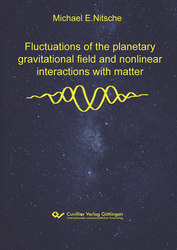| Fachbereiche | |
|---|---|
| Buchreihen (96) |
1378
|
| Nachhaltigkeit |
3
|
| Gesundheitswesen |
1
|
| Geisteswissenschaften |
2364
|
| Naturwissenschaften |
5406
|
| Mathematik | 229 |
| Informatik | 319 |
| Physik | 980 |
| Chemie | 1363 |
| Geowissenschaften | 131 |
| Humanmedizin | 243 |
| Zahn-, Mund- und Kieferheilkunde | 10 |
| Veterinärmedizin | 108 |
| Pharmazie | 147 |
| Biologie | 835 |
| Biochemie, Molekularbiologie, Gentechnologie | 121 |
| Biophysik | 25 |
| Ernährungs- und Haushaltswissenschaften | 45 |
| Land- und Agrarwissenschaften | 1004 |
| Forstwissenschaften | 201 |
| Gartenbauwissenschaft | 20 |
| Umweltforschung, Ökologie und Landespflege | 148 |
| Ingenieurwissenschaften |
1793
|
| Allgemein |
98
|
|
Leitlinien Unfallchirurgie
5. Auflage bestellen |
|
Erweiterte Suche
Fluctuations of the planetary gravitational field and nonlinear interactions with matter
Michael E. Nitsche (Autor)Vorschau
Leseprobe, PDF (410 KB)
Inhaltsverzeichnis, PDF (97 KB)
For the first time, extensive investigations have been carried out into the harmonics of the planetary gravitational field. Gravity is a force that acts both on large scales, the planetary system, and on small scales, on the micro scale of atoms. The kinematics of the planets correspond to oscillators that were stable over billions of years in evolution and were able to unfold their effect. The gravitational forces are weak and only directly perceptible to the senses in the coupling of the sun and moon in the tides. As in non-linear optics, the special effects of the fluctuating gravitational field only become visible in the harmonics. A correlation function constructed to show the change in probabilities for stable (harmonic) and unstable (disharmonic ) states is applied to a wide variety of situations and events.
The correlation function found has been used to study the structure formation of human intelligence, the stability of mental processes, the developmental psychology of humans, social events and crises, but also the triggering of earthquakes 2. The fluctuating planetary gravitational field forms frequency patterns that can be used for predictions in an artificial intelligence.
| ISBN-13 (Printausgabe) | 9783736978409 |
| ISBN-13 (E-Book) | 9783736968400 |
| Sprache | Englisch |
| Seitenanzahl | 86 |
| Auflage | |
| Erscheinungsort | Göttingen |
| Erscheinungsdatum | 10.07.2023 |
| Allgemeine Einordnung | Sachbuch |
| Fachbereiche |
Astrophysik und Astronomie
|
| Schlagwörter | Gravitation, Evolution, Planetensystem, Gravitationsfeld, Oberschwingungen, Erdbeben, Interaktionen mit Materie, nichtlineare Korrelationen, Fluktuationen, nichtlineare Wechselwirkungen, Korrelationsfunktion, Wahrscheinlichkeit, instabile Zustände, stabile Zustände, Triggerung von Erdbeben, Mikrogravitation, Gezeitenspannungen, Oberschwingungen des planetaren Gravitationsfeldes, Strukturbildungsprozesse, Intelligenz, psychische Instabilitäten, Statistik, künstliche Intelligenz, Schwache KI, Musterbildung, Mustererkennung, IQ Test, Hochbegabung, Zeitqualität, biografische Rhythmen, gekoppelte Oszillatoren, komplexe Systeme, nichtlineare Dynamik, Natur und Gesellschaft, kosmischen Rhythmen, oszillierende Teilsysteme, fluktuierende Gravitation, gravitative Wechselwirkungen, Astrophysik, Kosmologie, Risikobereitschaft,natürliche Oszillatoren, Simulationshypothese, Entwicklungspsychologie, Midlife Crisis, Gravity, evolution, planetary system, gravitational field, harmonics, earthquakes, interactions with matter, nonlinear correlations, fluctuations, nonlinear interactions, correlation function, probability, unstable states, stable states, triggering of earthquakes, microgravity, tidal stresses, harmonics of planetary gravitational field, structure formation processes, intelligence, mental instabilities, statistics, artificial intelligence, weak AI, pattern formation, pattern recognition, IQ test, giftedness, quality of time, biographical rhythms, coupled oscillators, complex systems, nonlinear dynamics, nature and society, cosmic rhythms, oscillating subsystems, fluctuating gravity, gravitational interactions, astrophysics, cosmology, risk taking, natural oscillators, simulation hypothesis, developmental psychology, midlife crisis |
| URL zu externer Homepage | http://www.planetare-korrelation.eu/ |








